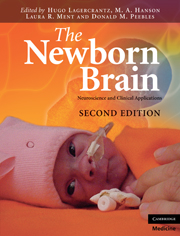Book contents
- Frontmatter
- Contents
- List of contributors
- Preface to the First Edition
- Preface to the Second Edition
- 1 Reflections on the origins of the human brain
- Section 1 Making of the brain
- Section 2 Sensory systems and behavior
- Section 3 Radiological and neurophysiological investigations
- Section 4 Clinical aspects
- Section 5 Follow-up
- 20 Injury and recovery in the developing brain
- 21 Development of motor functions in health and disease
- 22 Antenatal glucocorticoids and programming of neuroendocrine function and behavior
- Section 6 Consciousness
- Index
- Plate section
- References
21 - Development of motor functions in health and disease
from Section 5 - Follow-up
Published online by Cambridge University Press: 01 March 2011
- Frontmatter
- Contents
- List of contributors
- Preface to the First Edition
- Preface to the Second Edition
- 1 Reflections on the origins of the human brain
- Section 1 Making of the brain
- Section 2 Sensory systems and behavior
- Section 3 Radiological and neurophysiological investigations
- Section 4 Clinical aspects
- Section 5 Follow-up
- 20 Injury and recovery in the developing brain
- 21 Development of motor functions in health and disease
- 22 Antenatal glucocorticoids and programming of neuroendocrine function and behavior
- Section 6 Consciousness
- Index
- Plate section
- References
Summary
Theoretical framework of motor development
During recent decades knowledge on mechanisms governing motor control has rapidly increased. The expansion in knowledge was brought about by the development of sophisticated physiological, neurochemical, and imaging techniques. The idea that motor behavior was largely controlled by reflex mechanisms was abandoned. Nowadays, motility is regarded as the net result of the activity of complex spinal or brainstem machineries, which are subtly modulated by segmental afferent information and ingeniously controlled by supraspinal networks (Grillner et al., 1995, 2005). Functional imaging makes it increasingly clear that supraspinal activity is organized in large-scale networks, in which cortical areas continuously interact with intermediary cortical or subcortical (striatal, cerebellar) structures (Hikosaka et al., 2002; Molinari et al., 2002). In the light of motor development it is good to realize that, in particular, cortical-subcortical networks expanded during phylogeny and that these networks determine to a large extent human motor ontogeny. This does not, however, preclude developmental changes in the spinal cord and muscles: developmental changes in one part of the neuromuscular system affect those in other parts of the system.
Concurrent with the changes in insight into the neural mechanisms involved in motor control, knowledge on motor development has also increased – although at a considerably slower pace. This has led to changes in theoretical frameworks of the processes involved in the development of motor control.
- Type
- Chapter
- Information
- The Newborn BrainNeuroscience and Clinical Applications, pp. 345 - 360Publisher: Cambridge University PressPrint publication year: 2010



